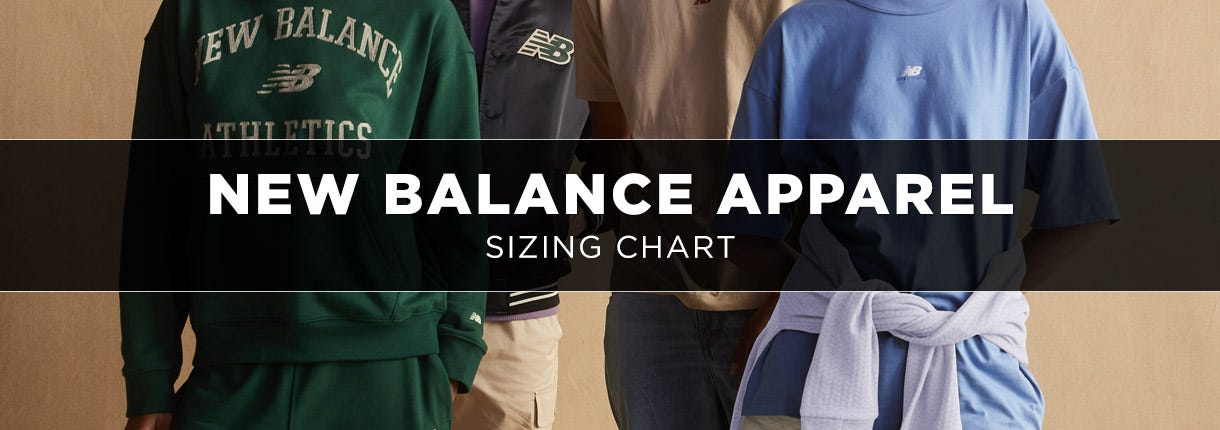New Balance Apparel Sizing Chart

Finding the perfect fitting New Balance apparel is key to maximizing your athletic performance and comfort. Clothes that are too tight can restrict movement and chafe, while baggy garments can feel cumbersome and hinder your flow. A well-fitting outfit allows for optimal range of motion, promotes breathability, and boosts your confidence on the field or during your workout.
In this article, we’ll cover:
Why Sizing Matters in New Balance Apparel
Proper sizing goes beyond aesthetics. The right fit in New Balance apparel enhances your athletic performance by allowing for unrestricted movement and flexibility. It also ensures optimal comfort during exercise, preventing chafing and irritation. For everyday wear, a well-fitting New Balance outfit flatters your body type and provides a sense of ease throughout the day.
New Balance Clothing Size Chart
The New Balance size chart categorizes clothing by size (e.g., small, medium, large) and may also include corresponding chest, waist, and hip measurements. Some charts might include inseam lengths for bottoms. By comparing your body measurements to the chart, you can identify the size that best corresponds to your dimensions.
Men's Sizing
| Size | Chest (in.) | Waist (in.) | Seat (in.) | Inseam (in.) |
|---|---|---|---|---|
| XX-Small | 33" - 35" | 26" - 28" | 33" - 35" | 29" |
| X-Small | 35" - 37" | 28" - 30" | 35" - 37" | 29" |
| Small | 37" - 39" | 30" - 32" | 37" - 39" | 30" |
| Medium | 39" - 41" | 32" - 34" | 39" - 41" | 31" |
| Large | 41" - 43" | 34" - 36" | 41" - 43" | 32" |
| X-Large | 45" - 47" | 38" - 40" | 45" - 47" | 33" |
| XX-Large | 49" - 51" | 42" - 44" | 49" - 51" | 34" |
| XXX-Large | 53" - 55" | 46" - 48" | 53" - 55" | 34 1/2" |
| XXXX-Large | 57" - 59" | 50" - 52" | 57" - 59" | 35" |
Youth Sizing
| Size | Chest (in.) | Waist (in.) | Seat (in.) | Inseam (in.) |
|---|---|---|---|---|
| X-Small (8) | 27" | 23 1/2" | 27 1/2" | 22 1/2" |
| Small (10) | 28 1/2" | 25" | 29" | 25" |
| Medium (12) | 30" | 27" | 30 1/2" | 27" |
| Large (14) | 31 1/2" | 28 1/2" | 33" | 29" |
| X-Large (16) | 34" | 30" | 35 1/2" | 31" |
Please Note: These sizing charts are for reference only and may not reflect personal preference.
Step-by-Step Guide to Using the New Balance Size Chart
Taking accurate body measurements is crucial for using the New Balance size chart effectively. Here's a detailed guide:
Step 1: Gather Your Tools
You'll need a measuring tape, a pen, and a piece of paper to record your measurements.
Step 2: Measure Your Chest
Wrap the measuring tape around the fullest part of your chest, keeping it level across your back. Breathe normally while taking the measurement.
Step 3: Measure Your Waist
Find your natural waistline (typically above your belly button) and wrap the measuring tape comfortably around it. Avoid holding your breath or sucking in your stomach.
Step 4: Measure Your Hips
Stand with your feet shoulder-width apart and measure around the fullest part of your hips and buttocks.
Step 5: Measure Your Inseam
For pants and leggings, find the inseam by measuring the inner leg from the crotch seam down to your desired ankle length. You can take this measurement with an existing pair of well-fitting pants.
Step 6: Measure Your Sleeve Length (Optional for Tops)
With your arm relaxed at your side, measure from the shoulder seam down to your desired sleeve length (wrist, elbow, etc.)
Expert Tip:
When measuring, take each measurement twice to ensure accuracy. If you fall between sizes, consider the activity you'll be using the garment for. Choose the larger size for looser-fitting workout clothes and the smaller size for a more fitted look.
Tips for Selecting the Right Size in Different Apparel Types
Selecting your curve and blade pattern is just as important as choosing the right size. This chart categorizes Bauer's most popular curves based on depth, face angle, and other key specifications to help you find the perfect fit for your playing style.
Tops and T-Shirts
New Balance offers a variety of fits, including regular, slim, and relaxed. Choose the fit that best complements your body type and desired level of movement. Your chest measurement is the primary factor for tops. Refer to the size chart to find the corresponding size based on your chest measurement. If you prefer a longer or shorter fit in your tops, consider sizing up or down accordingly.
Bottoms and Tights
Waist and inseam measurements are crucial for finding well-fitting bottoms and tights. Ensure the waist measurement aligns comfortably and the inseam length reaches your desired ankle position. New Balance offers different rise options (low, mid, high) for bottoms. Choose the rise that best suits your comfort preference and activity level.
Outerwear
If you plan to layer underneath your outerwear, choose a size that allows for comfortable layering without feeling restrictive. For jackets, measure your sleeve length to ensure the sleeves reach your desired point on your wrists. Outerwear should allow for a full range of motion without feeling constricting.
Common Mistakes to Avoid When Using the New Balance Size Charts
Mistake 1: Ignoring the Measurement Guide
Always refer to the size chart and take accurate body measurements before selecting a size.
Mistake 2: Relying Solely on Size Labels
Sizing can vary between brands and even between styles within New Balance.
Mistake 3: Assuming One-Size-Fits-All
New Balance offers a wide range of sizes and fits, including regular, slim, and relaxed. Consider your body type and desired fit when choosing a size.
Mistake 4: Not Checking New Balance Reviews
Customer reviews can offer valuable insights on the fit of specific New Balance clothing items.
FAQs on New Balance Apparel Size Chart & Guide
What if I am between sizes?
If you fall between sizes, refer to the "Expert Tip" in the Step-by-Step Guide section for recommendations based on your activity.
Do New Balance clothes run true to size?
New Balance apparel generally fits true to size. However, it's always recommended to consult the size chart and consider any reviews mentioning fit before purchasing.
How do I know if I've measured correctly?
Double-check your measurements and compare them to the New Balance size chart to ensure accuracy. If in doubt, seek assistance from customer service or visit a retail store for professional fitting.











